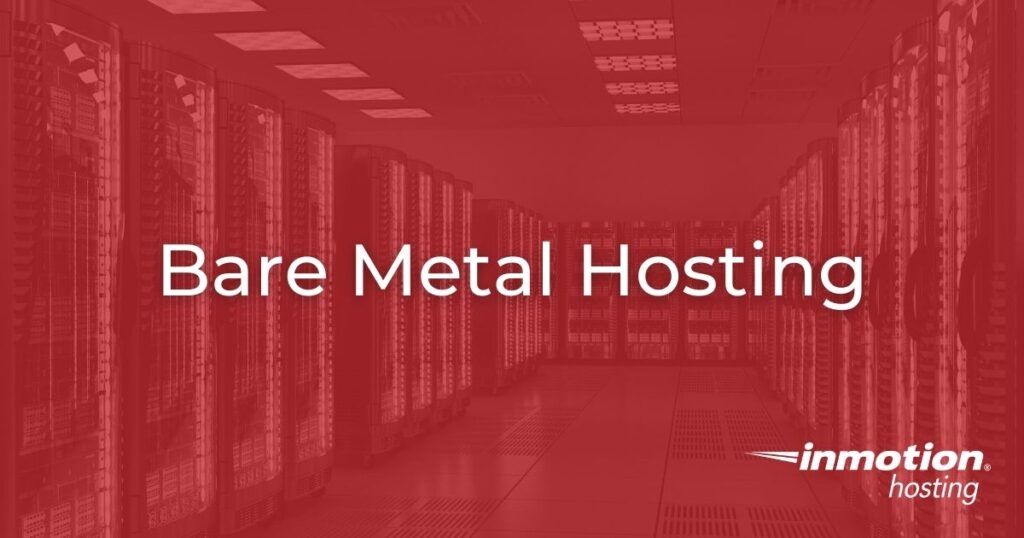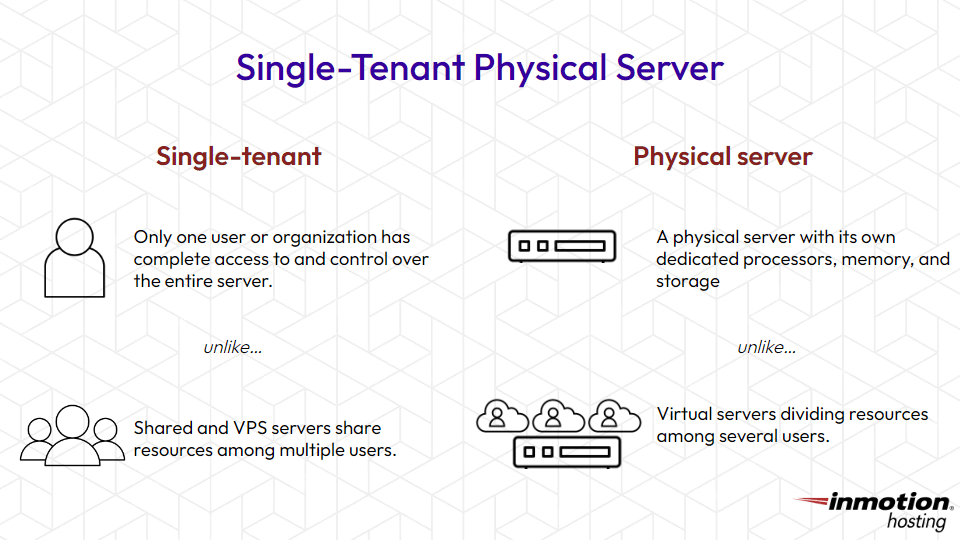
When attempting to determine which type of server is best for your needs, you may find yourself looking for a hosting solution that simply provides the hardware and allows you to install whichever operating system you prefer. Instead of purchasing a pre-configured CentOS server with cPanel and WHM already installed, Bare Metal Servers offer you the opportunity to customize the Dedicated Server to suit your individual needs. In this article, we will explore why Bare Metal Servers may be the right choice for you as well as discuss how it differs from other forms of server hosting.
Topics Include:
Take your digital presence to the next level through state-of-the-art hardware and your preferred operating system with Bare Metal Servers!
What is a bare metal server?
Bare metal servers are single-tenant, physical servers. This type of server is distinct from virtualized or cloud-based server hosting, as it does not rely on a layer of virtualization to create the server environment. As each server only holds a single-tenant, there is no sharing of resources that would typically occur on a cloud-based virtual server.
What does “single-tenant physical server” mean?
In order to explain the meaning of the term single-tenant physical server, we’ll break it down into its two different parts:

Single-tenant
The term “single-tenant” means that only one user or organization has complete access to and control over the entire server. Unlike shared servers, where multiple users divvy up resources, a single-tenant setup ensures that all the server’s power, memory, storage, and network capabilities are dedicated to one user.
Physical server
The term “physical server” refers to a tangible and real piece of hardware, akin to a physical computer you can touch. It’s not a virtual or simulated machine. This physical server stands in contrast to virtual alternatives like a VPS or Virtual Private Server. While a physical server has its dedicated processors, memory, and storage, a VPS operates as a simulated server within a larger physical server, sharing resources with other virtual servers
What does “bare metal” actually mean?
The term “bare metal server” is derived from the idea that the server operates directly on the “bare metal” or physical hardware without any intervening layers, such as a hypervisor or virtualization software. In a traditional server environment, there might be layers of virtualization that abstract the hardware and create virtual machines. These virtual machines run on a hypervisor, which is essentially another layer between the software and the actual hardware.
A bare metal server, however, skips these virtualization layers. It’s a single-tenant physical server dedicated to a specific user or organization. Because it operates directly on the bare metal, it can provide more direct and efficient access to the server’s resources, resulting in better performance and lower latency.
The term “bare metal” emphasizes the lack of abstraction or intermediary layers, highlighting the direct relationship between the server’s software and the underlying hardware. This characteristic makes bare metal servers particularly well-suited for applications and workloads that require high performance, predictable resource allocation, and low-level customization of hardware configurations.
Why Use Bare Metal?
Bare metal servers offer the highest levels of customization and performance capabilities. State-of-the-art hardware can be combined with your choice of operating system, giving you the power and flexibility that is not available in other types of server infrastructure. This type of platform is useful for web developers and those looking to create a high-performance sandbox environment for website or application development. Bare Metal servers can also serve as a jumping-off point for enterprises looking to set up automation strategies to create their own cloud infrastructure.
Bare Metal Servers vs. Dedicated Servers
The difference between a bare metal server and a dedicated server lies in how they operate on the underlying hardware. A bare metal server runs directly on the physical hardware without a virtualization layer, ensuring optimal performance as it commands exclusive access to all resources. On the other hand, a dedicated server could mean either a traditional one, which may use virtualization and share resources among multiple virtual machines, or a bare metal server.
The key difference is that bare metal servers provide a higher level of isolation and customization, making them ideal for high-performance tasks, while the performance of traditional dedicated servers may be affected by virtualization overhead.
Bare metal vs. VPS Servers
Bare metal servers and VPS (Virtual Private Server) servers differ significantly in their architecture, performance characteristics, and use cases.
Physical vs. Virtual Environment
A bare metal server is a physical server entirely dedicated to a single tenant. It runs directly on the hardware without any virtualization layer, providing direct access to the server’s resources.
A VPS server is a virtualized server environment created by partitioning a physical server into multiple virtual servers. Each VPS operates as an independent entity with its own operating system and resources.
Performance
Bare Metal Servers offers superior performance since it has exclusive access to all the resources of the physical server, without the overhead of virtualization.
VPS Server performance may be impacted by the virtualization layer, as multiple virtual servers share the same underlying hardware resources.
Isolation and Security
Bare Metal Servers provide a higher level of isolation since there are no other virtualized environments on the same hardware. This alone gives bare metal security a one-up.
While virtualization provides some level of isolation for vps servers, security considerations may arise due to shared hardware resources.
Customization
Bare Metal Servers offers more customization options for hardware configurations, allowing users to tailor the server to specific requirements.
VPS Servers are limited with customization, with users having control over the virtual environment but not the physical hardware.
Bare Metal vs. Flex Metal
While researching the server infrastructure that is right for you, you have likely come across the terms bare metal and flex metal, sometimes used interchangeably to refer to an unmanaged server that provides flexibility in terms of OS installation. At this point, it is worth taking a look at the differences between Flex Metal and Bare Metal server platforms.
Flex Metal
Flex Metal refers to a virtualized, cloud-based server platform that comes with a pre-configured operating system of your choice. This differs from standard cloud-based VPS platforms that only offer one operating system. Flex metal servers exist in virtual environments, oftentimes with several tenants occupying the same physical space. While this form of hosting is more affordable, it requires that system resources be shared among all server residents, creating resource availability issues that may interfere with your web-based applications and websites.
Bare Metal
Bare Metal servers, as previously mentioned, differ from Flex Metal servers in that Bare Metal servers exist as single-tenant, physical servers that can have a variety of operating systems pre-installed. This differs from standard dedicated servers that only offer a single choice of operating system, providing an additional level of customization in addition to the hardware options that are typically available to dedicated servers. As system resources are not shared among multiple tenants, bare metal servers are better suited for resource-intensive applications. For additional information, check out our guide on Migrating to Bare Metal.
When evaluating your server infrastructure options, understanding the pros and cons of bare metal servers and their Flex Metal counterparts will empower you to make an informed decision that aligns with your specific requirements.
Managed vs Unmanaged
Another pair of terms you have likely seen when researching dedicated server hosting are managed and unmanaged. While these terms mean slightly different things depending on the hosting provider, generally they each refer to a distinct style of support that is offered for each product.
Managed servers are supported by a full team of system administrators that monitor the backend systems involved in your server hosting experience. This is great for users that want to focus on the front-end aspects of their web presence and not worry about the system administration tasks. Generally, managed servers come pre-installed with a GUI-based control panel such as cPanel that allows for easier management of server functionalities. As such, Managed Servers may be better suited for users that aren’t as comfortable with command-line interfaces.
Unmanaged servers differ in that they do not receive this same support, making it vitally important for users to set up their own monitoring systems and provide their own system administration. This option is great for users that want to take complete control of their server experience and handle all aspects of system administration as they see fit. Generally, unmanaged servers do not come pre-installed with a GUI-based control panel and must be managed using the command-line interface. This makes unmanaged servers better suited for users that would prefer the efficiency facilitated by command-line utilities.
Bare Metal Use Cases:
Bare metal servers are used across a spectrum of industries and computing needs, owing to their unique advantages in performance, control, and reliability. Here are some key use cases:
High-Performance Computing (HPC)
Bare metal servers are instrumental in high-performance computing environments where processing power and speed are paramount. Industries such as scientific research, weather modeling, and financial simulations benefit from the raw computing power and low-latency access to hardware resources that bare metal servers provide.
Data-Intensive Applications
Applications dealing with vast amounts of data, such as big data analytics and large-scale databases, benefit from the dedicated resources and direct hardware access of bare metal servers. This ensures efficient data processing and reduces latency for critical operations.
Content Delivery Networks (CDN)
CDNs, responsible for delivering web content efficiently, often leverage bare metal servers to ensure consistent and low-latency content delivery. The direct access to hardware resources allows for optimized content caching and delivery, improving the overall user experience.
Database Hosting
Hosting databases on bare metal servers ensures reliable and high-performance database operations. This is crucial for applications that rely heavily on database transactions, such as e-commerce platforms, content management systems, and enterprise resource planning (ERP) systems.
Gaming Infrastructure:
In the gaming industry, particularly for online multiplayer games and streaming platforms, bare metal servers provide the necessary computational power and low latency for a seamless gaming experience. They are capable of handling the demands of real-time processing and high concurrent user loads.
Games today often feature sophisticated graphics, intricate environments, and realistic physics. To render these elements in real time, gaming servers require powerful GPUs (Graphics Processing Units) and CPUs (Central Processing Units) to handle the intense computational load.
Now that you are familiar with the differences between Flex and Bare Metal server platforms, you are better equipped to decide if Bare Metal Servers are right for you!
